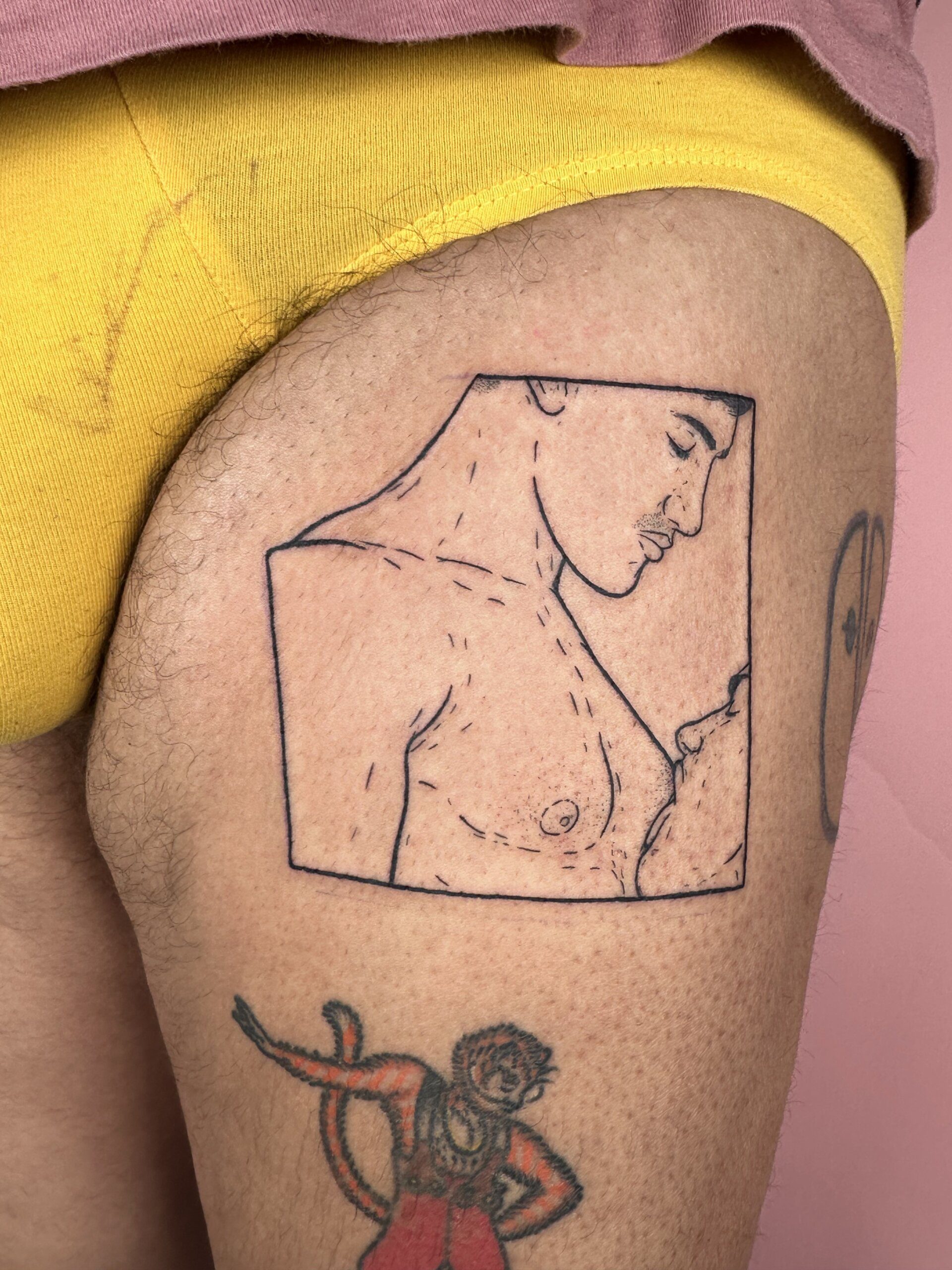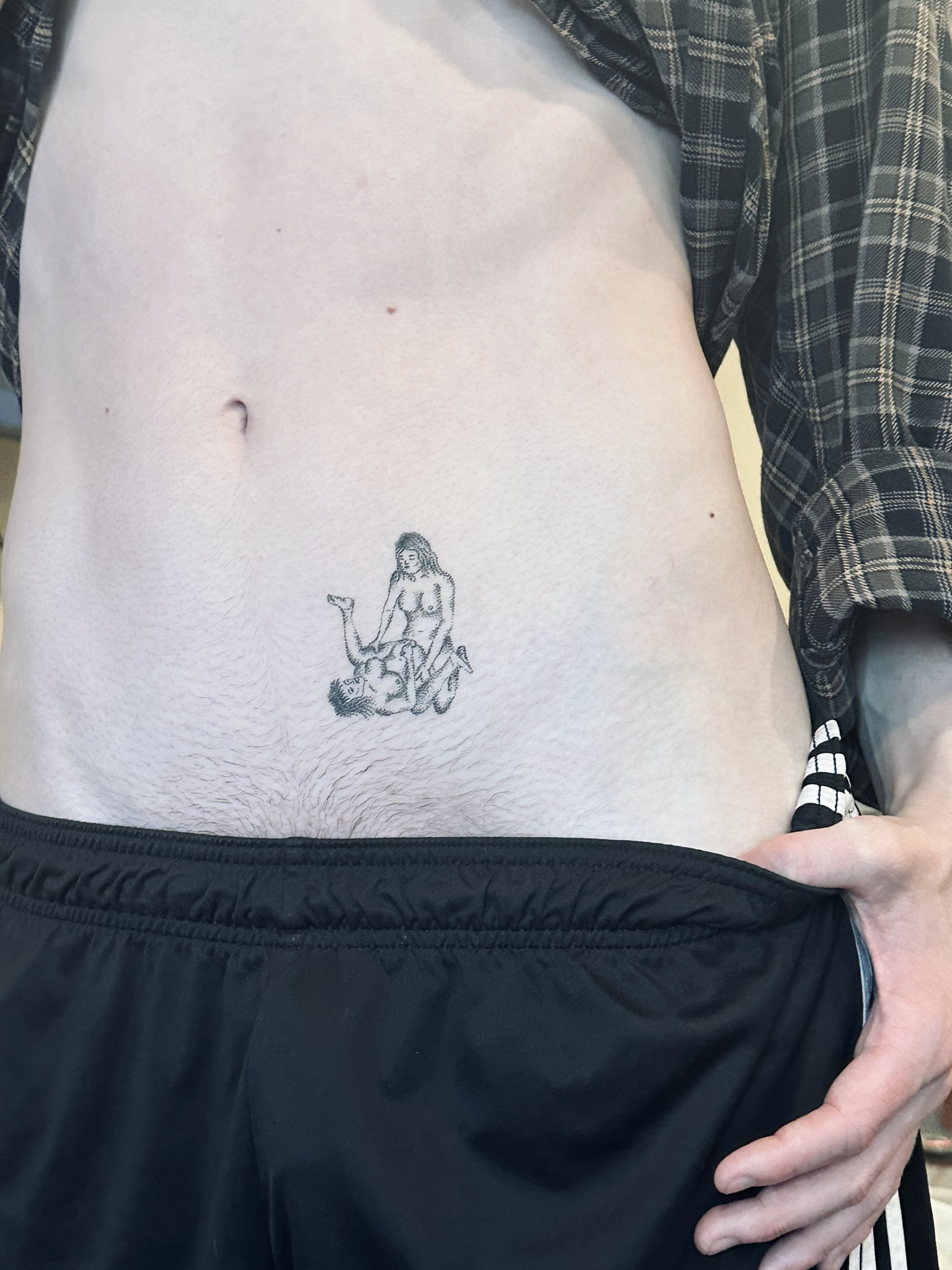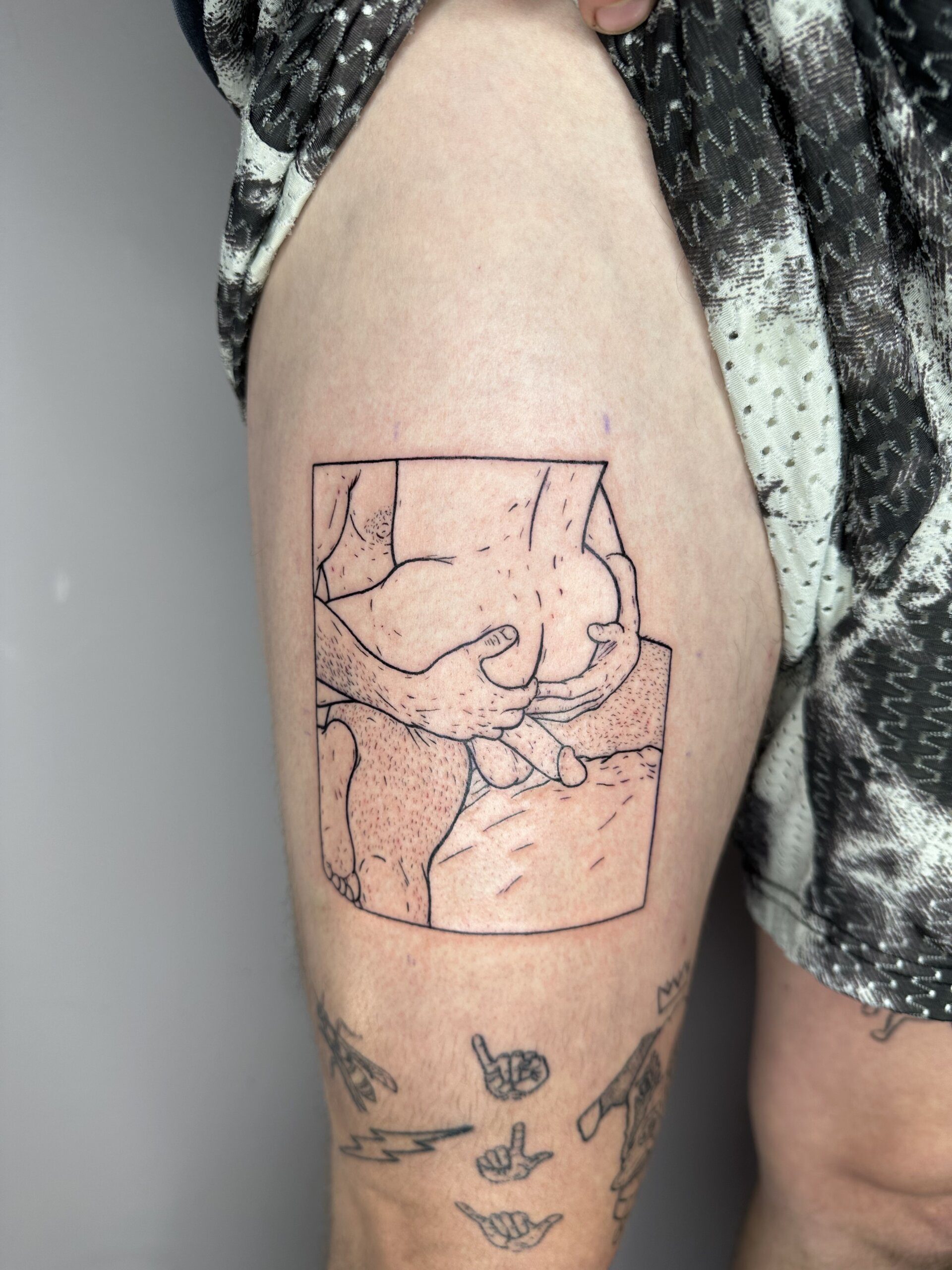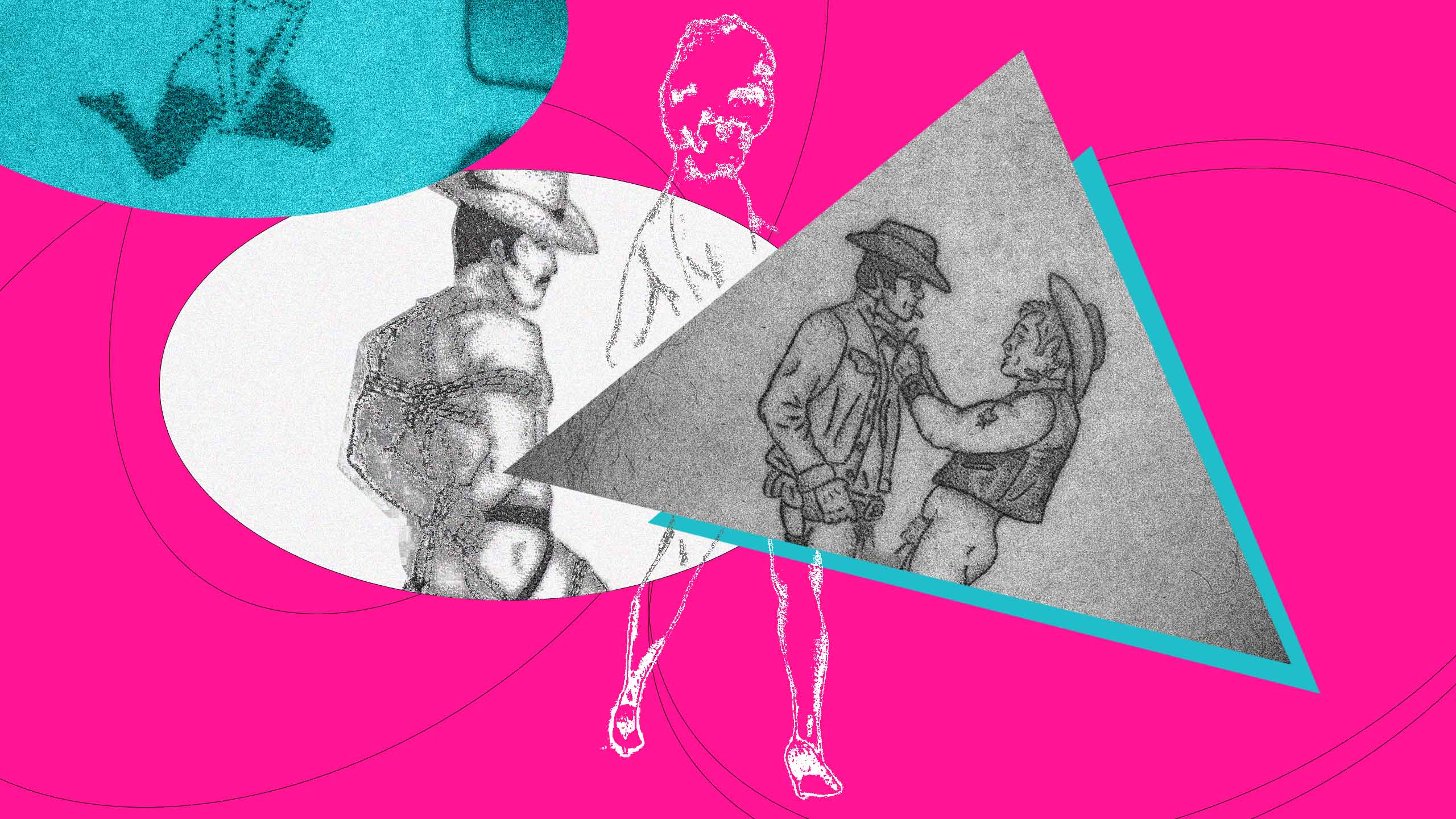Tattoos are like photographs: snapshots in time imbued with hopefully fond memories. And if you’re a collector like me, tattoos are a timeline of where you’ve been, who you’ve been with, what you’ve done (take that as you will). A tour down my forearms is a journey through first loves, best friends, split-second decisions and momentous milestones.
For LGBTQ2S+ people, tattoos can be private nods to our queerness—small tokens only visible to us and to those we grant access. Or they can be dramatic, obvious displays of our place in this world, spanning entire limbs or purposefully placed to catch the eyes of passersby.

An erotic tattoo done by Vancouver-based artist Ethan Barry. Credit: Ethan Barry
Erotic tattoos have become a favourite among queer artists and clients alike as a way to embrace their radical imagery and send a powerful political statement to all who may see them.
For Chicago-based nurse practitioner Johnny Perez, his erotic tattoos are a way to show confidence and strength in his identity. Perez boasts a handful of erotic tattoos of various kinds, including a muscle bear in a jockstrap riding a banana, a poppers ad and pieces inspired by seminal queer artists including Keith Haring and Cliff Raven (a man known as Chicago’s “gay grandaddy of tattooing”).
“Sometimes [patients] get to know me before they see them because I wear a white coat,” Perez tells Xtra. “So I give them one impression. Then if I don’t wear a coat and they see them, it’s a little shocking at first. But we talk about it and it helps update their perception of people with tattoos, but also queer people in general.”
Perez, who has previously done HIV-related research as a nurse, said he plans to work as an HIV/sexual health specialist. He says many of his tattoos relate to that work and spark conversation with patients, including a piece depicting Haring’s Once Upon a Time mural painted in the bathroom of The Center: Lesbian, Gay, Bisexual & Transgender Community Center in New York City. The wall-spanning work is smutty, dick-cum-and-ass-filled bacchanalia that serves as an homage to the days of queer sex before HIV/AIDS took hold.
“I think they show people who I am and that I’m not hiding who that person is,” Perez says. “They let people know I’m not scared to be this person.”
For other queer people, that same power comes from the furtive nature of their tattoos. Eleanor, a New York-based trans woman who didn’t want to use her full name because of the hypersexual nature of her tattoo, intentionally placed her erotic tattoo just above her pubic area. Eleanor and a friend got matching designs, a handpoke design of two trans women in the throes of sex. She says the surreptitious placement of the tattoo is part of what makes it erotic.
“It’s something that only my sexual partners are going to see,” she says “And I like that sort of layer of privacy. And it grants me the capacity to choose to whom I reveal this little piece. The agency that I have in choosing whom I get to display the tattoo to is very cool.”
On a simpler matter, she says it’s also just “hot to have girl-on-girl action on your body; it’s sexy.”

Eleanor’s tattoo, picturing two trans women having sex, done by New York artist Elliot F. Marone. Credit: Courtesy Eleanor
Both Eleanor and fellow New Yorker Alivia Hernández separately sought out artist Elliot F. Marone for their erotic tattoos. Marone, who goes by both @faggytats and @transmascwithanass on Instagram, has made a name for himself as a skilled purveyor of smutty tattoos.
Hernández recently got a handpoke piece from Marone of a woman sitting on her knees, wearing only black leggings with her breasts exposed. Even though the image isn’t as hypersexual as other designs, Hernández says the nudity speaks to her regardless.
“I feel like it’s something that when people are looking at my tattoos and looking at my sleeve, it does make me feel much more connected to the fact that I do love women and I like to celebrate femininity in every single way,” Hernández says. “And also being sexually and romantically attracted to women.”
Marone works out of Macondo Tattoo in Brooklyn, New York City, and has been tattooing since 2020—but not just tattoo scenes of unfiltered sexuality. He also tattoos imagery that has been increasingly co-opted by queer people (cowboys are a recent, resurging trend, he says) as well as words like “faggot” and “dyke” that are being reclaimed by queer people who use them proudly.
“Especially right now, of course, with the political climate, there’s a lot of backlash,” Marone says. “So having those designs and tattoos on your body is very radical in its own sense.”
Ethan Barry, a Vancouver-based multidisciplinary artist who works out of Homebody Tattoo, says the erotic aspects of his tattoo work are an extension of his other artistic practices—all of which he says focuses on making “quiet but impactful” pieces.
Posts of Barry’s work on his instagram, @gaptoothb, boast striking, crisp linework that twist and turn into scenes of unabashed eroticism. You’ll see faces buried between ass cheeks, tongues finding shafts and nipples, muscular bodies trapped under tense, tightly bound rope. Those scenes are broken up by the occasional orchid, insect or other more chaste imagery.

An erotic tattoo done by Vancouver-based artist Ethan Barry. Credit: Ethan Barry
And when he tattoos more erotic designs, Barry says, those are often moments of powerful connection with his clients.
“Often those tattoo sessions lead to really productive, amazing conversations between myself and the client about what they’re going through in their lives, what they experience sexually as a queer person, why they’re getting those tattoos, what it means to them,” Barry says. “And sometimes that can be very purposeful. Other times, it’s like, ‘I’m a slut and I love the subject matter.’”
Both Barry and Marone say they’ve seen overwhelmingly positive reactions to their work from other queer people, and they see that as a testament to queer people wanting to embrace their identity in some fashion—in this case through tattoos.
“The majority of people who are getting these pieces are either approaching it from a place where they are already embracing this part of their life very fully, or trying to do that more and are getting these pieces as a reminder and a permanent embodiment of them wanting to live their life more in alignment with what they’re putting on their body,” Barry says.

An erotic tattoo featuring two cowboys, done by New York artist Elliot F. Marone. Credit: Elliot F. Marone
Beyond aesthetics, a throughline in these erotic works is the culture that they buck up against. Even the buzzing of a tattoo gun can’t drown out the cacophony of the backlash queer people are facing around the globe. And that’s just to even the most basic sanitized queer representation, let alone erotic art.
These tattoos don’t happen in a vacuum. For queer people deciding to depict uncensored sexuality on their bodies, the experience of getting and then living with such a permanent design can be powerful. And by co-opting traditions of tattoos as a means to objectify women (including when women get the tattoos themselves), these artists and their clients are queering the art form in meaningful ways.
“This is a type of tattoo that I feel like really marks me—literally marks me as a queer person,” Hernández says. “And it just is kind of saying ‘I like this. I think this is beautiful. I celebrate this. And this is my choice. It’s my body. I put it on there forever and ever and ever. And you can kind of go fuck yourself.’”
Inside the Queer Ink series …
Series editor Mel Woods introduces the history behind queer and trans people and tattooing, and dives into how tattooing has played a key role in their own life and identity. (Oct. 2, 2023)
Lindsay Lee Wallace explores the A Thousand Pansies Project, an initiative to use tattooing as queer collective care. (Oct. 4, 2023)
Xtra staff share the stories behind some of our own gayest tattoos. (Oct. 10, 2023)
Adam Rhodes dives deep into erotic tattoos and the queers who choose to get them. (Oct. 12, 2023)
BJ Ferguson explores the world of post-op top surgery tattoos. (Oct. 17, 2023)
Julia Peterson profiles some of the Two-Spirit tattooers using the artform to express and explore identity.
Next up: From new nipples to elaborate designs, how top surgery can provide a blank slate ready for tattooing.


 Why you can trust Xtra
Why you can trust Xtra


